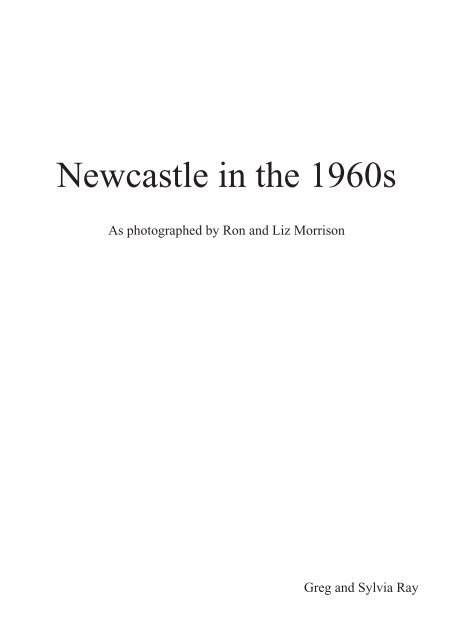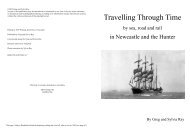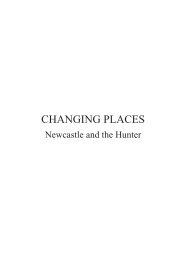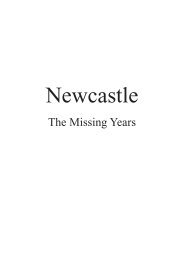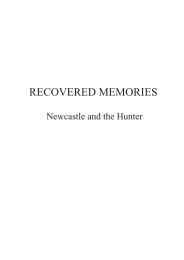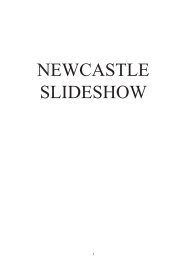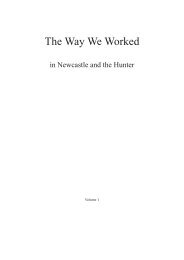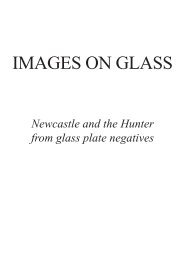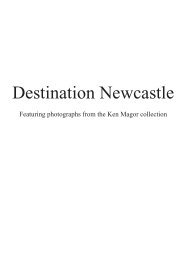Pages from Newcastle in the 1960s
You also want an ePaper? Increase the reach of your titles
YUMPU automatically turns print PDFs into web optimized ePapers that Google loves.
<strong>Newcastle</strong> <strong>in</strong> <strong>the</strong> <strong>1960s</strong><br />
As photographed by Ron and Liz Morrison<br />
Greg and Sylvia Ray
©2017 Greg and Sylvia Ray<br />
No part of this publication may be reproduced or transmitted <strong>in</strong> any form or by any means electronic<br />
or mechanical, and <strong>in</strong>clud<strong>in</strong>g photocopy<strong>in</strong>g, record<strong>in</strong>g or by <strong>in</strong>formation storage and retrieval systems,<br />
without <strong>the</strong> written permission of <strong>the</strong> copyright owner.<br />
Pr<strong>in</strong>ted by NCP Pr<strong>in</strong>t<strong>in</strong>g, Steel River, <strong>Newcastle</strong><br />
Published by Greg and Sylvia Ray<br />
Concept and design by Greg and Sylvia Ray<br />
Research and captions by Greg Ray<br />
Photographs by Ron and Liz Morrison<br />
Image enhancement by Sylvia Ray<br />
ISBN 978-0-9871883-8-0<br />
Front cover: Telephoto view of Hunter Street, <strong>Newcastle</strong> West, <strong>in</strong> <strong>the</strong> late <strong>1960s</strong>.<br />
Back cover: The BHP steelworks, dom<strong>in</strong>at<strong>in</strong>g <strong>the</strong> skyl<strong>in</strong>e <strong>in</strong> a view <strong>from</strong> a Mayfield street.<br />
Title page vignette: A classic <strong>Newcastle</strong> scene of <strong>the</strong> <strong>1960s</strong>, with BHP steelworks dom<strong>in</strong>at<strong>in</strong>g a typical<br />
suburban landscape featur<strong>in</strong>g rotary clo<strong>the</strong>sl<strong>in</strong>es and tall television antennae.
<strong>Newcastle</strong> <strong>in</strong> <strong>the</strong> <strong>1960s</strong><br />
As photographed by Ron and Liz Morrison<br />
by Greg and Sylvia Ray
A kaleidoscopic survey of <strong>the</strong> steel city<br />
In <strong>the</strong> <strong>1960s</strong> <strong>Newcastle</strong> was an <strong>in</strong>dustrial city full of contrasts. Employment <strong>in</strong> <strong>the</strong> heavy <strong>in</strong>dustries that<br />
dom<strong>in</strong>ated <strong>the</strong> city was plentiful and relatively well-paid, support<strong>in</strong>g a prosperous and busy community.<br />
But <strong>the</strong> tough years of World War II and <strong>the</strong> Great Depression were not all that long past, and those events<br />
and circumstances left marks that were still visible on <strong>the</strong> city as <strong>the</strong> <strong>1960s</strong> dawned. Indeed, <strong>the</strong> decade had<br />
scarcely begun before a harsh credit squeeze struck, and some of <strong>the</strong> consequences – <strong>in</strong>dustrial trouble and a<br />
chronic hous<strong>in</strong>g shortage – are h<strong>in</strong>ted at by some of <strong>the</strong> photographs <strong>in</strong> this book.<br />
Technology, much of it triggered by a rapid global surge <strong>in</strong> production, research and development prompted<br />
by <strong>the</strong> war, was giv<strong>in</strong>g birth to <strong>the</strong> consumer society now so familiar to Australians. The statewide electricity<br />
grid made it possible for new markets <strong>in</strong> electrical consumer goods to expand. New fashions <strong>in</strong> music and<br />
enterta<strong>in</strong>ment likewise fed <strong>in</strong>to <strong>the</strong> growth of consumerism. People began to demand better homes, better<br />
cars, better clo<strong>the</strong>s and better education for <strong>the</strong>ir children.<br />
Television became ubiquitous and began to carve <strong>in</strong>to <strong>the</strong> markets previously occupied by radio and<br />
newspapers. The controversial Vietnam War took place aga<strong>in</strong>st this backdrop of “new media”, which almost<br />
certa<strong>in</strong>ly made it even more unpopular than conscription and political dissent had already done.<br />
And yet society was still conservative by <strong>the</strong> standards of <strong>the</strong> 21st Century. Censorship was <strong>the</strong> norm, <strong>in</strong><br />
films, books and o<strong>the</strong>r publications. Most <strong>in</strong>stitutions were heavily dom<strong>in</strong>ated by males. White Australia<br />
was still taken for granted as a social standard. Aborig<strong>in</strong>al Australians were only granted <strong>the</strong> right to vote <strong>in</strong><br />
1962, and were only <strong>in</strong>cluded <strong>in</strong> <strong>the</strong> Census <strong>in</strong> 1967.<br />
This book does not attempt to canvas or illustrate all <strong>the</strong> issues and developments that affected <strong>Newcastle</strong><br />
<strong>in</strong> <strong>the</strong> <strong>1960s</strong>. Its focus is kept necessarily narrow by <strong>the</strong> fact that it draws on <strong>the</strong> work of only two<br />
photographers, husband and wife team Ron and Elizabeth Morrison, whose output was relatively restricted<br />
by <strong>the</strong> demands of <strong>the</strong> commercial and media clients for whom <strong>the</strong>y mostly worked. Even with those<br />
constra<strong>in</strong>ts, however, <strong>the</strong> photographs displayed here certa<strong>in</strong>ly reflect many aspects of life <strong>in</strong> <strong>Newcastle</strong> and<br />
its surround<strong>in</strong>g areas <strong>in</strong> <strong>the</strong> period <strong>from</strong> 1959 to <strong>the</strong> early 1970s.<br />
On <strong>the</strong> whole this book is a compilation of m<strong>in</strong>utiae: small and ephemeral details of <strong>the</strong> k<strong>in</strong>d for which<br />
news publications had an <strong>in</strong>satiable appetite. Put toge<strong>the</strong>r <strong>the</strong>y form a kaleidoscopic survey of a city and a<br />
time now gone, with faces, places, events and activities that are certa<strong>in</strong> to jog <strong>the</strong> memories of many readers.<br />
<strong>Newcastle</strong> has long<br />
had a reputation as<br />
“a graveyard for<br />
newspapers”. Among<br />
<strong>the</strong> many short-lived<br />
newspaper ventures<br />
<strong>the</strong> city has seen<br />
was <strong>the</strong> <strong>Newcastle</strong><br />
Sunday Mirror, a<br />
local wrap-around<br />
on <strong>the</strong> established<br />
Sydney publication.<br />
It appeared <strong>in</strong> 1959<br />
and lasted about 18<br />
months. Many of <strong>the</strong><br />
photographs <strong>in</strong> this<br />
book were taken by<br />
Ron and Liz Morrison<br />
for use <strong>in</strong> this paper.<br />
4
Ron <strong>in</strong> <strong>the</strong> dark-room of The Maitland Mercury. Liz Morrison poses with a Rolleicord camera and flash.<br />
Ron Morrison started work as a cadet photographer with The <strong>Newcastle</strong> Herald and <strong>Newcastle</strong> Sun <strong>in</strong><br />
1949, learn<strong>in</strong>g <strong>from</strong> such f<strong>in</strong>e teachers as Milton Merrilees and Arch Miller. In later years he and his wife<br />
Liz started <strong>the</strong>ir own press agency, provid<strong>in</strong>g photographs to newspapers and magaz<strong>in</strong>es across Australia.<br />
Ron taught photography at <strong>the</strong> National Art School and at <strong>Newcastle</strong> College of Advanced Education,<br />
where he became head of <strong>the</strong> Department of Visual Arts Communication.<br />
Elizabeth Morrison taught history at <strong>Newcastle</strong> Technical College <strong>from</strong> 1973, becom<strong>in</strong>g head teacher.<br />
She also worked as a freelance journalist for many years and taught professional writ<strong>in</strong>g at Charles Sturt<br />
University <strong>in</strong> Bathurst.<br />
Between <strong>the</strong>m, <strong>the</strong> pair has many books to <strong>the</strong>ir credit, <strong>in</strong>clud<strong>in</strong>g two collections of Novocastrian<br />
photographs, <strong>Newcastle</strong> Seen (1989) and <strong>Newcastle</strong>, Times Past (2005).<br />
In more recent years <strong>the</strong>y have also published <strong>Newcastle</strong>, Heart of <strong>the</strong> Hunter (2007) and Those Were <strong>the</strong><br />
Days, Australia <strong>in</strong> <strong>the</strong> Sixties (2013).<br />
Hav<strong>in</strong>g been our mentors and friends for many years, and hav<strong>in</strong>g provided valued advice on <strong>the</strong> publication<br />
of our own books, Ron and Liz suggested we acquire <strong>the</strong>ir private collection of photographic pr<strong>in</strong>ts and<br />
negatives for use <strong>in</strong> our own publish<strong>in</strong>g and research endeavours. We gratefully agreed, and quickly realised<br />
that <strong>the</strong> collection conta<strong>in</strong>ed many images that deserved to be assembled <strong>in</strong>to a new book <strong>in</strong> <strong>the</strong>ir own right,<br />
with no dilution by photographs <strong>from</strong> o<strong>the</strong>r sources.<br />
It was <strong>in</strong>terest<strong>in</strong>g that Ron and Liz <strong>in</strong>itially regarded some of <strong>the</strong> images <strong>in</strong>volved as likely to be mundane<br />
and un<strong>in</strong>terest<strong>in</strong>g to readers. Once <strong>the</strong>y were scanned, however, <strong>the</strong> negatives were acknowledged to have<br />
acquired great <strong>in</strong>terest, by virtue of <strong>the</strong> passage of time. On <strong>the</strong>ir re-emergence <strong>from</strong> obscurity <strong>the</strong>y have<br />
been found to conta<strong>in</strong> enormous amounts of fasc<strong>in</strong>at<strong>in</strong>g detail about places and people <strong>in</strong> <strong>Newcastle</strong>’s past.<br />
We thank Ron and Liz for <strong>the</strong>ir generosity, and hope that this book br<strong>in</strong>gs <strong>the</strong>ir f<strong>in</strong>e work to <strong>the</strong> notice of<br />
many people who might not yet have encountered it <strong>in</strong> o<strong>the</strong>r contexts.<br />
Greg Ray<br />
5
Above left: Liz was photographed at Maitland Courthouse by a press colleague while cover<strong>in</strong>g <strong>the</strong> gruesome<br />
“double-headless murders” that rocked <strong>the</strong> Hunter <strong>in</strong> 1960 (see page 188). Right: Ron Morrison captures<br />
a self-portrait while tak<strong>in</strong>g an “arty” reflection shot <strong>in</strong> <strong>the</strong> chrome headlamp of a fire eng<strong>in</strong>e <strong>in</strong> <strong>Newcastle</strong>.<br />
Below left: A picturegram mach<strong>in</strong>e, used <strong>in</strong> pre-digital days to transmit photographs via telephone l<strong>in</strong>es.<br />
Right: The form once required when send<strong>in</strong>g picturegrams us<strong>in</strong>g <strong>the</strong> facilities of Australian post offices.<br />
When Ron and Liz Morrison needed to transmit images to distant newspaper customers <strong>the</strong>y usually<br />
used <strong>the</strong> picturegram mach<strong>in</strong>es provided by <strong>the</strong> Australian Post Office. Bigger newspapers had <strong>the</strong>ir own<br />
picturegram vans which <strong>the</strong>y would send to locations where important news stories were break<strong>in</strong>g.<br />
In order to have an acceptable quality pr<strong>in</strong>t available to “gram” Ron and Liz often used Polaroid film <strong>in</strong><br />
addition to <strong>the</strong>ir more conventional photomedia. The <strong>in</strong>stant develop<strong>in</strong>g capability of <strong>the</strong> Polaroid meant an<br />
image <strong>from</strong> a major story could be at <strong>the</strong> newspaper customer’s office <strong>in</strong> a remarkably short time.<br />
The photograph at <strong>the</strong> top of <strong>the</strong> page opposite was taken by Ron with Polaroid film, specifically to enter<br />
<strong>the</strong> 1962 National Polaroid Photography Contest. One of <strong>the</strong> features of <strong>the</strong> contest was that <strong>the</strong> w<strong>in</strong>n<strong>in</strong>g<br />
picture was to be shown on <strong>the</strong> Tommy Hanlon television show, It Could be You. Ron said he used a zoom<br />
lens to obta<strong>in</strong> a big, bold image with enough contrast to look good on television. The vegemite-lov<strong>in</strong>g<br />
children were <strong>Newcastle</strong> youngsters David and Elizabeth Anderson. The prize was £100 cash, and <strong>the</strong><br />
photograph at <strong>the</strong> bottom of <strong>the</strong> page shows Ron collect<strong>in</strong>g <strong>the</strong> prize <strong>from</strong> Greenson Photographics, <strong>the</strong><br />
Melbourne-based agents for Polaroid products.<br />
6
Ron’s prize-w<strong>in</strong>n<strong>in</strong>g shot of David and Elizabeth Anderson (above) and Ron collect<strong>in</strong>g his prize (below).<br />
7
Nicely framed shots of <strong>Newcastle</strong> <strong>from</strong> Fort Scratchley (above), and activity at <strong>the</strong> fort <strong>in</strong> May 1969 (below).<br />
8
Two views of <strong>Newcastle</strong>, look<strong>in</strong>g east over Bank Corner, probably taken <strong>from</strong> <strong>the</strong> top of Latec House.<br />
9
Hunter Street, east of Bolton Street. The charm<strong>in</strong>g former Bank of NSW build<strong>in</strong>g can be seen, beh<strong>in</strong>d <strong>the</strong> bus.<br />
10
Look<strong>in</strong>g south along Bolton Street, towards <strong>the</strong> courthouse. Steel’s Garage and Legacy House on left.<br />
June 1969: <strong>Newcastle</strong> Post Office, with Norman Brown’s newspaper kiosk on <strong>the</strong> Bolton Street footpath.<br />
11
Look<strong>in</strong>g across Hunter Street to <strong>the</strong> Merewe<strong>the</strong>r Street railway level cross<strong>in</strong>g. Sobb’s furniture store at right.<br />
Ano<strong>the</strong>r view of <strong>the</strong> Merewe<strong>the</strong>r Street <strong>in</strong>tersection. The sign po<strong>in</strong>ts to <strong>the</strong> way to <strong>the</strong> Stockton Ferry wharf.<br />
Look<strong>in</strong>g <strong>from</strong> <strong>the</strong> Merewe<strong>the</strong>r Street <strong>in</strong>tersection across Hunter Street to <strong>the</strong> Frederic Ash hardware store.<br />
12
Look<strong>in</strong>g across Hunter Street towards <strong>the</strong> Civic Theatre and Wheeler Place <strong>from</strong> Civic Railway Station.<br />
August 1960: Service station attendant Joe Hattam shows <strong>the</strong> grime <strong>from</strong> pass<strong>in</strong>g steam tra<strong>in</strong>s that has<br />
settled on a car. The angry service station owner tried to make railway authorities pay for car washes.<br />
13
Above: The David Cohen build<strong>in</strong>g <strong>in</strong> Bolton Street, January 1960. Below: Outside Pal<strong>in</strong>gs store, Hunter Street.<br />
14
Two views of <strong>the</strong> K<strong>in</strong>g Street Terraces. Above: Look<strong>in</strong>g east <strong>from</strong> <strong>the</strong> terraces, across K<strong>in</strong>g Street. Below:<br />
Park<strong>in</strong>g <strong>in</strong>spector Jock Miller takes a long hard look at an FJ Holden parked near Crown Street <strong>in</strong> November<br />
1959. Residents of <strong>the</strong> terrace houses compla<strong>in</strong>ed that <strong>the</strong>y had to shift <strong>the</strong>ir cars before 7.30am to avoid f<strong>in</strong>es.<br />
15
Strange case of <strong>the</strong> migrat<strong>in</strong>g gravestones<br />
<strong>Newcastle</strong>’s Christ Church Ca<strong>the</strong>dral boasts a lovely park that overlooks <strong>the</strong> city and provides views out<br />
across <strong>the</strong> harbour. It’s a precious oasis of calm <strong>in</strong> <strong>the</strong> middle of <strong>the</strong> city, and a perfect spot for a picnic on a<br />
sunny day. Of course, beneath <strong>the</strong> ground lie <strong>the</strong> bodies of those buried long ago <strong>in</strong> <strong>the</strong> ca<strong>the</strong>dral graveyard.<br />
Off to <strong>the</strong> side of <strong>the</strong> park some of <strong>the</strong> stones, moved <strong>from</strong> <strong>the</strong>ir orig<strong>in</strong>al positions, can be seen.<br />
The photographs on <strong>the</strong> page opposite show some of <strong>the</strong> gravestones still <strong>in</strong> place, before <strong>the</strong>y were shifted<br />
and before an unknown number of <strong>the</strong>m were removed to become landscap<strong>in</strong>g aids at Blackbutt Reserve.<br />
Sharp-eyed visitors to Blackbutt can sometimes spot stones <strong>in</strong> <strong>the</strong> gardens with fragments of <strong>in</strong>scriptions<br />
on <strong>the</strong>m, and some of <strong>the</strong>se have been identified as parts of particular memorials.<br />
Former <strong>Newcastle</strong> City Council ranger Ray Raisbeck told me some years ago how, as a lead<strong>in</strong>g hand <strong>in</strong> <strong>the</strong><br />
mid-<strong>1960s</strong>, he and o<strong>the</strong>r workers were assigned to clear scrub <strong>from</strong> <strong>the</strong> overgrown graveyard.<br />
‘‘We had to use a cha<strong>in</strong>saw and tractor to get some of <strong>the</strong> bushes out of <strong>the</strong> iron fences around some of <strong>the</strong><br />
graves,’’ Mr Raisbeck told me <strong>in</strong> 2007. The council catalogued and photographed many of <strong>the</strong> stones <strong>in</strong> <strong>the</strong><br />
1970s before shift<strong>in</strong>g a handful to <strong>the</strong> ca<strong>the</strong>dral park’s eastern end. Many were placed face up, level with<br />
<strong>the</strong> lawn. By <strong>the</strong>n Mr Raisbeck had moved to become caretaker at Blackbutt, and he said he received many<br />
tombstones <strong>from</strong> <strong>the</strong> ca<strong>the</strong>dral which he used for landscap<strong>in</strong>g.<br />
‘‘Some stones were offered to anybody who wanted <strong>the</strong>m and I remember a lovely red granite one,<br />
belong<strong>in</strong>g to a Clunes Innes, that was taken to Port Macquarie,’’ he said.<br />
Many of <strong>the</strong> stones had been vandalised and broken before <strong>the</strong>y arrived at Blackbutt. Vandals had bored<br />
<strong>in</strong>to many crypts and stolen r<strong>in</strong>gs and o<strong>the</strong>r items <strong>from</strong> bodies.<br />
The Christ Church stones were used <strong>in</strong> many parts of Blackbutt, notably <strong>the</strong> Carnley Avenue entrance<br />
walls. ‘‘They largely consisted of broken stones or stones <strong>from</strong> <strong>the</strong> surrounds of graves or crypts. Odd bits<br />
and pieces had <strong>in</strong>scriptions or detailed carv<strong>in</strong>gs,’’ Mr Raisbeck said.<br />
Among <strong>the</strong> gravestones lost <strong>in</strong> <strong>the</strong> park clean-up was that of Henry Chatfield, capta<strong>in</strong> of <strong>the</strong> ill-fated<br />
steamer Cawarra, wrecked by a storm while enter<strong>in</strong>g <strong>the</strong> harbour <strong>in</strong> 1866, with terrible loss of life.<br />
A view of part of <strong>Newcastle</strong> <strong>in</strong> <strong>the</strong> <strong>1960s</strong>, tak<strong>in</strong>g <strong>in</strong> <strong>the</strong> Scotts build<strong>in</strong>g, <strong>the</strong>n occupied by David Jones, and<br />
Lynch’s prawn shop partly visible on <strong>the</strong> right. Christ Church Anglican Ca<strong>the</strong>dral dom<strong>in</strong>ates <strong>the</strong> skyl<strong>in</strong>e at rear.<br />
16


